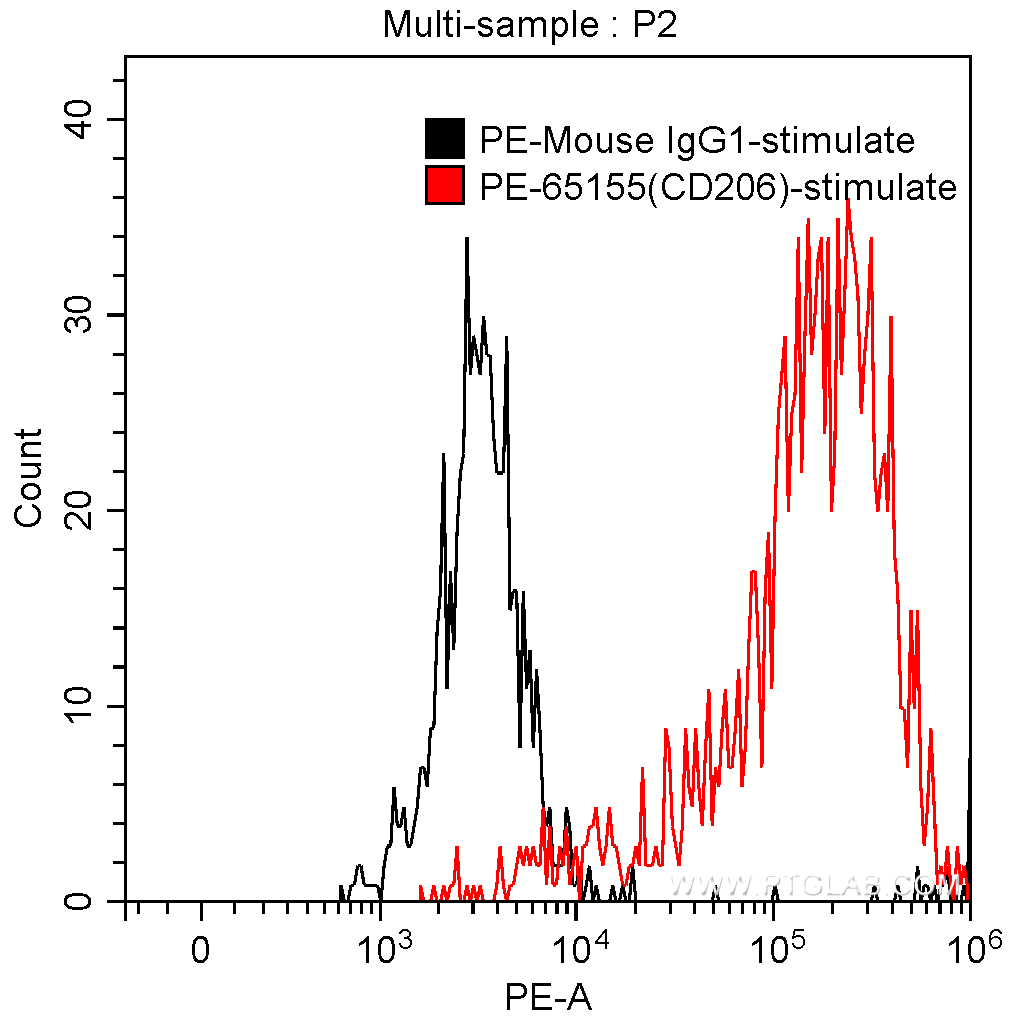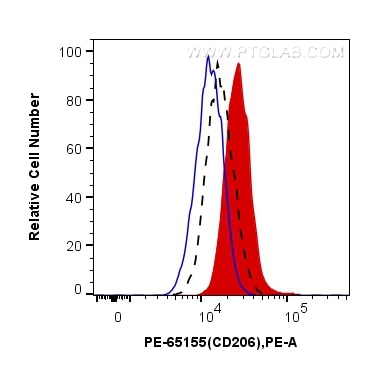Anticorps Monoclonal anti-CD206
CD206 Monoclonal Antibody for FC
Hôte / Isotype
Mouse / IgG1, kappa
Réactivité testée
Humain
Applications
FC
Conjugaison
PE Fluorescent Dye
CloneNo.
15-2
N° de cat : PE-65155
Synonymes
Galerie de données de validation
Applications testées
| Résultats positifs en cytométrie | cellules cellules dendritiques dérivées de monocytes humains, IL-4 and IL-13-stimulated THP-1-derived macrophages |
Dilution recommandée
| Application | Dilution |
|---|---|
| This reagent has been pre-titrated and tested for flow cytometric analysis. The suggested use of this reagent is 10 µl per 10^6 cells in a 100 µl suspension or 10 µl per 100 µl of whole blood. | |
| Sample-dependent, check data in validation data gallery | |
Applications publiées
| FC | See 4 publications below |
Informations sur le produit
PE-65155 cible CD206 dans les applications de FC et montre une réactivité avec des échantillons Humain
| Réactivité | Humain |
| Réactivité citée | Humain |
| Hôte / Isotype | Mouse / IgG1, kappa |
| Clonalité | Monoclonal |
| Type | Anticorps |
| Immunogène | Récepteur de mannose humain purifié |
| Nom complet | mannose receptor, C type 1 |
| Masse moléculaire calculée | 166 kDa |
| Numéro d’acquisition GenBank | NM_002438 |
| Symbole du gène | MRC1 |
| Identification du gène (NCBI) | 4360 |
| Conjugaison | PE Fluorescent Dye |
| Excitation/Emission maxima wavelengths | 496 nm, 565 nm / 578 nm |
| Forme | Liquide |
| Méthode de purification | L'anticorps purifié est conjugué à la R-phycoérithrine (PE) dans des conditions optimales. Le conjugué est purifié par chromatographie d'exclusion de taille. |
| Tampon de stockage | PBS avec azoture de sodium à 0,1 %. |
| Conditions de stockage | Store at 2-8°C. Avoid exposure to light. Stable for one year after shipment. |
Informations générales
CD206, also named as MMR, CLEC13D and MRC1, is a type I membrane receptor that mediates the endocytosis of glycoproteins by macrophages. CD206 has been shown to bind high-mannose structures on the surface of potentially pathogenic viruses, bacteria, and fungi so that they can be neutralized by phagocytic engulfment. CD206 is a 170 kDa transmembrane protein which contains 5 domains: an amino-terminal cysteine-rich region, a fibronectin type II repeat, a series of eight tandem lectin-like carbohydrate recognition domains (responsible for the recognition of mannose and fucose), a transmembrane domain, and an intracellular carboxy-terminal tail. It is expressed on most tissue macrophages, in vitro derived dendritic cells, lymphatic and sinusoidal endothelia.
Protocole
| Product Specific Protocols | |
|---|---|
| FC protocol for PE CD206 antibody PE-65155 | Download protocol |
| Standard Protocols | |
|---|---|
| Click here to view our Standard Protocols |
Publications
| Species | Application | Title |
|---|---|---|
Oncogene Dual role of pseudogene TMEM198B in promoting lipid metabolism and immune escape of glioma cells | ||
J Agric Food Chem Polysaccharide from Ziyang Selenium-Enriched Green Tea Prevents Obesity and Promotes Adipose Thermogenesis via Modulating the Gut Microbiota | ||
Eur J Histochem Tumor cells-derived exosomal PD-L1 promotes the growth and invasion of lung cancer cells in vitro via mediating macrophages M2 polarization | ||
Biomed Pharmacother Vorinostat decrease M2 macrophage polarization through ARID1A6488delG/HDAC6/IL-10 signaling pathway in endometriosis-associated ovarian carcinoma |



